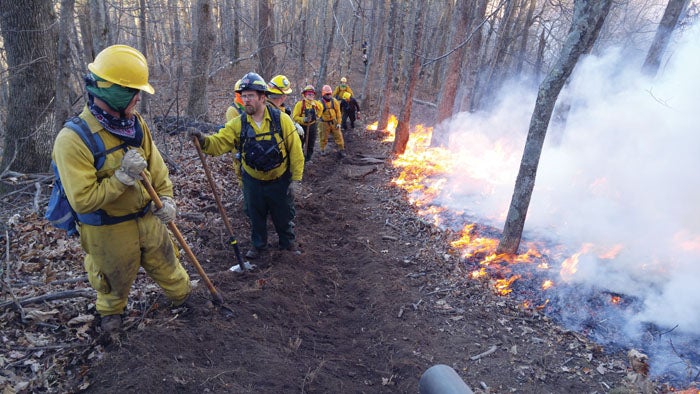Firewise landscape planning helps minimize risks of wildfires
Published 12:00 am Friday, December 8, 2017

- N.C. Forest Service firefighters battle a blaze near Lake Lure in 2016.
By Amy-Lynn Albertson
Rowan County Extension director
In Oregon and Montana this past summer, more than a million acres burned in wildfires. In California, fires continue to burn destroying many homes and livelihoods.
In Rowan County, it has started to get dry again, and wildfires are not unheard of in our area. In fact, a 2000 study showed that our state ranks No. 1 in the amount of land that falls inside “Wildland Urban Interface” zones and No. 5 in the number of homes (41 percent) in those zones.
This, taken with the fact that wildfire is a natural part of the state’s ecosystems, illustrates the danger that many residents live under. It is not a matter of “if” a wildfire will occur but “when” it will happen.
Many N.C. residents are not aware that they are living on the edge of a wildfire disaster. While structural firefighters, often working in conjunction with the N.C. Forest Service, work diligently to suppress wildfires, the simple truth is that few fire departments have the resources to protect every home in a wildfire-susceptible area.
Even with adequate equipment, the design of many communities makes it difficult for firefighters to safely access threatened homes. The dangers mean that homeowners must take the initiative to protect their property and neighborhoods before a wildfire occurs.
The North Carolina Firewise and Firewise Communities/USA programs provide information for homeowners, builders, planners, developers and fire officials to help mitigate the risks associated with wildfire. According to the N.C. Drought Monitor, Rowan County is “abnormally dry” while Stanly County just south of us is in a “moderate drought.”
With the dry air and plenty of leaf fuel on the ground, a wildfire is a potential danger. As a homeowner, there are several things you can do to protect your home from wildfire and prevent wildfires from starting.
Instead of burning your leaves, compost them. Leaf compost is an excellent source of organic matter to add to your flower beds, vegetable gardens and so one. If you are not a gardener, you can rake your leaves into a wooded area where they can break down naturally over time and add nutrients to the forest floor.
A 30-foot buffer of survivable space is recommended between your home and any wooded area. Survivable space doesn’t mean you cannot have trees in your yard. Nor does it mean that your landscape will be bare or that it won’t attract wildlife.
Instead, firewise concepts allow you to make decisions about what you value while taking steps to reduce your risk.
You should select plants with a low flammability rating for the areas nearest your house. Plants that are resistant to wildfire grow without accumulating large amounts of combustible dead branches, needles or leaves like flowering dogwood. Look for plants that have open, loose branches and a low volume of total vegetation like a strawberry bush.
Plant a variety of types and species. Besides being aesthetically pleasing and more attractive to a wide range of wildlife, a variety of plants will help to ensure a healthier landscape by reducing insect and disease problems.
Plants that are stressed from insects and diseases are more flammable because of the loss of vigor and increased amount of dead, dry plant material.
A landscape is a dynamic system that is constantly changing. Conducting seasonal maintenance activities, such as pruning, will help you maintain the plants’ firewise properties by keeping them green and healthy.
Cut and remove the dried foliage of annual and perennial herbaceous plants. Rake up and dispose of plant litter as it builds up over the season. Remove dead shrubs and any vegetation encroaching on power lines.
It’s critical to remove any branches within 15 feet of a chimney or roof.
The best time to prune is late winter and early spring to reduce large amounts of regrowth.
Wildfire can significantly reduce the resources and services produced by North Carolina’s wild lands, including wildlife habitat, recreation, clean water, timber, and scenic beauty.
As the state’s population grows and residential development increases, the risk increases that a wildfire will encroach upon homes. Some homeowners may have to deal only with smoke and evacuation. For others, fire often destroys their homes and property.
By using firewise landscaping strategies, homeowners can create landscapes with less potential fuel for a fire and minimize the risk of a wildfire spreading to their home.
For more information about firewise landscaping or forestry, contact the Rowan County Extension Center at 704-216-8970 or the North Carolina Forest Service at 704-216-8993.





